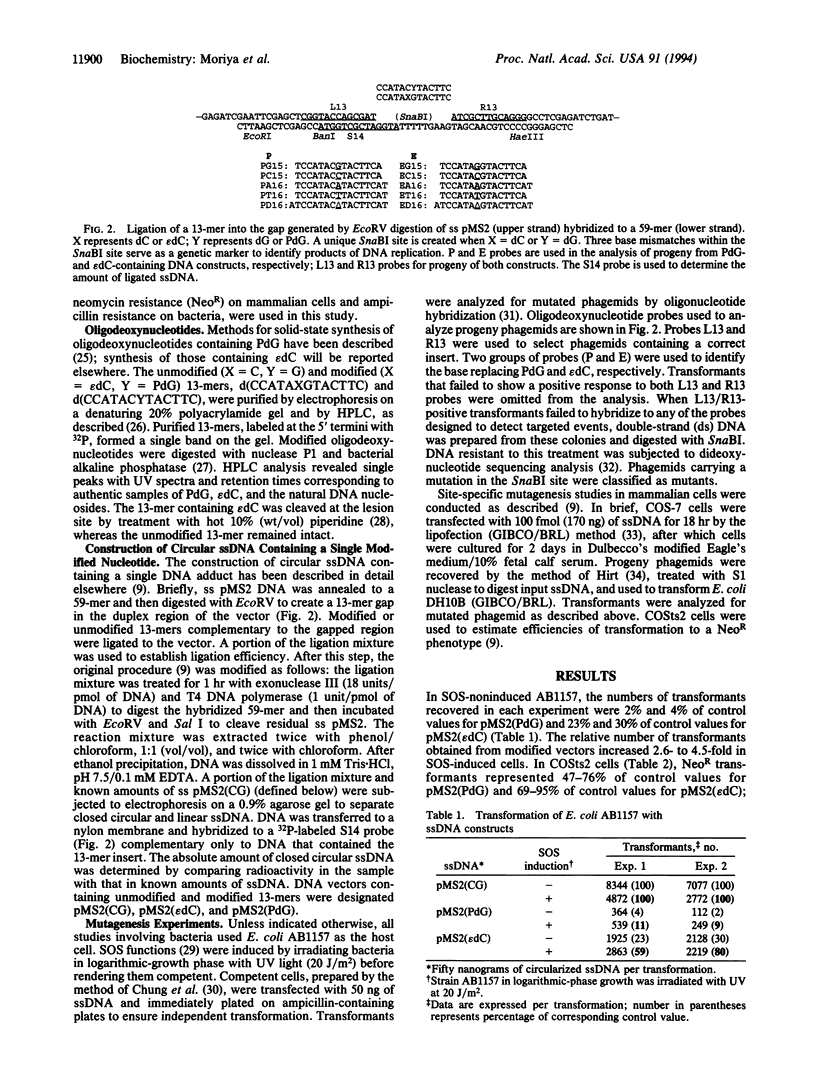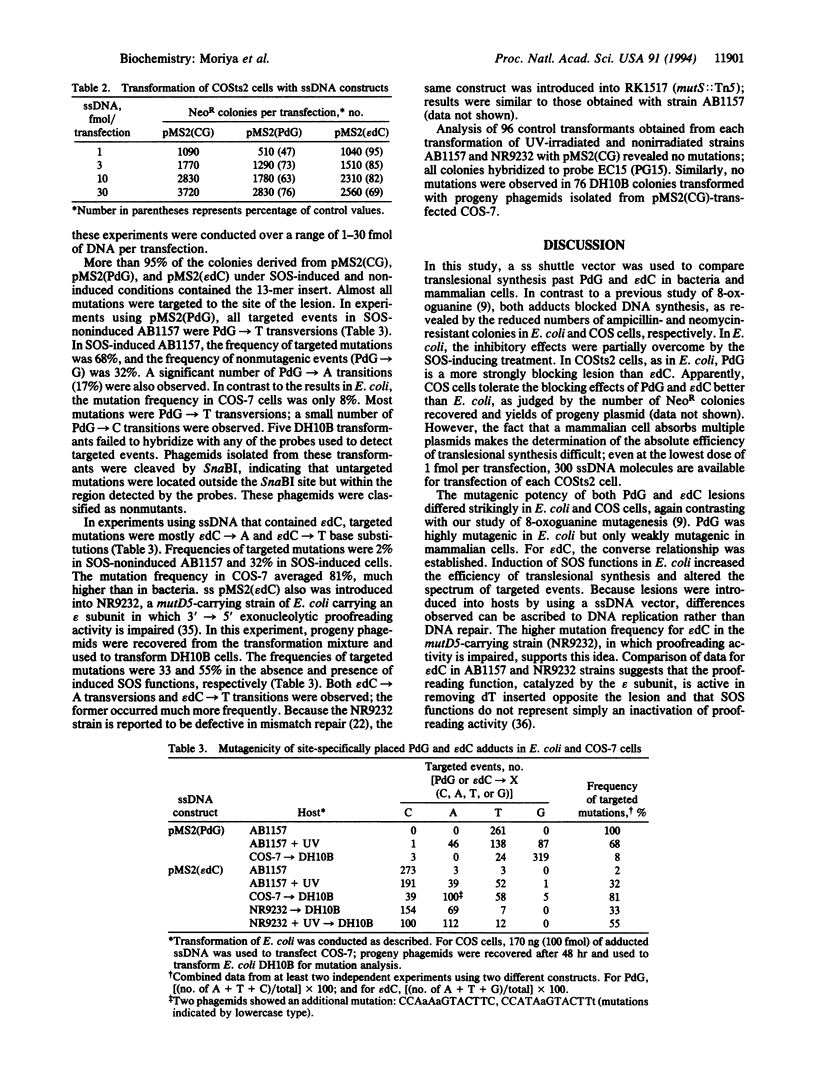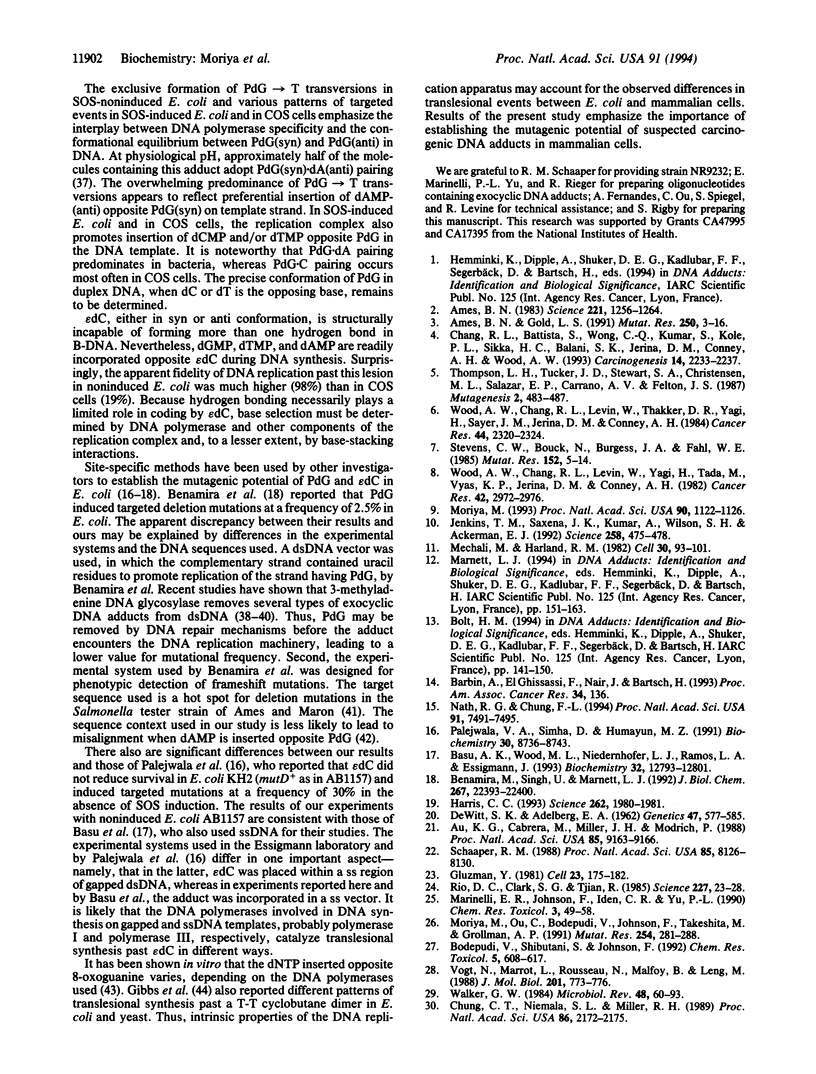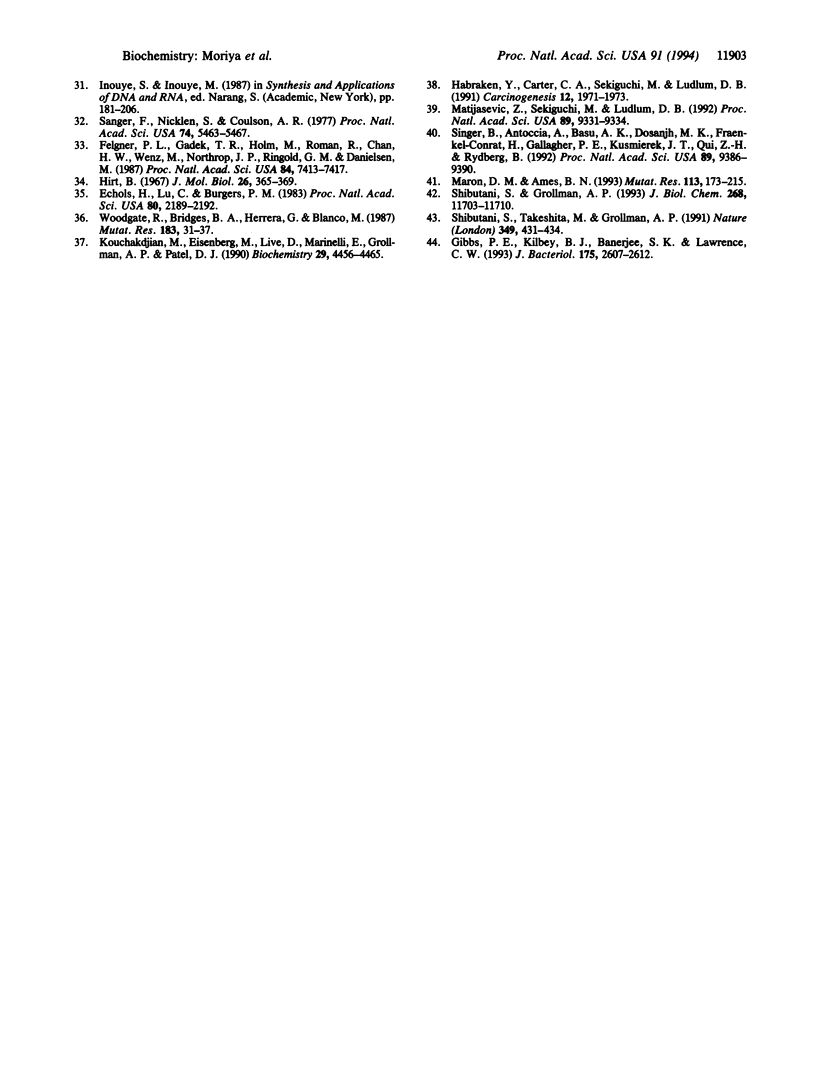Abstract
A single-stranded shuttle vector containing a single 3,N4-etheno-2'-deoxycytidine (epsilon dC) or 1,N2-(1,3-propano)-2'- deoxyguanosine (PdG) DNA adduct was used to investigate translesional DNA synthesis in Escherichia coli and simian kidney (COS) cells. The presence of either exocyclic adduct was associated with reduced numbers of transformants. In E. coli, this inhibitory effect could be overcome partially by irradiating cells with UV light before transformation. Translesional synthesis past both exocyclic lesions was accompanied by targeted mutations. For PdG, the primary mutagenic events observed in both hosts were PdG-->T transversions; in preirradiated E. coli, PdG-->A transitions were also observed. The targeted mutation frequency for single-stranded DNA that contained PdG was 100% in nonirradiated E. coli, 68% in preirradiated cells, and 8% in COS cells. In contrast, the targeted mutation frequency for single-stranded DNA that contained epsilon dC was 2% in nonirradiated E. coli, 32% in preirradiated cells, and 81% in COS cells. The primary mutations generated by epsilon dC in both E. coli and COS cells were epsilon dC-->A and epsilon dC-->T base substitutions. These observations appear to reflect the variable specificity of DNA replication complexes in incorporating bases opposite certain adducts. We conclude that DNA synthesis past the same DNA adduct can have strikingly different consequences in bacteria and mammalian cells, underscoring the importance of establishing the intrinsic mutagenic potential of DNA adducts in mammalian cells.
Full text
PDF




Selected References
These references are in PubMed. This may not be the complete list of references from this article.
- Ames B. N. Dietary carcinogens and anticarcinogens. Oxygen radicals and degenerative diseases. Science. 1983 Sep 23;221(4617):1256–1264. doi: 10.1126/science.6351251. [DOI] [PubMed] [Google Scholar]
- Ames B. N., Gold L. S. Endogenous mutagens and the causes of aging and cancer. Mutat Res. 1991 Sep-Oct;250(1-2):3–16. doi: 10.1016/0027-5107(91)90157-j. [DOI] [PubMed] [Google Scholar]
- Au K. G., Cabrera M., Miller J. H., Modrich P. Escherichia coli mutY gene product is required for specific A-G----C.G mismatch correction. Proc Natl Acad Sci U S A. 1988 Dec;85(23):9163–9166. doi: 10.1073/pnas.85.23.9163. [DOI] [PMC free article] [PubMed] [Google Scholar]
- Basu A. K., Wood M. L., Niedernhofer L. J., Ramos L. A., Essigmann J. M. Mutagenic and genotoxic effects of three vinyl chloride-induced DNA lesions: 1,N6-ethenoadenine, 3,N4-ethenocytosine, and 4-amino-5-(imidazol-2-yl)imidazole. Biochemistry. 1993 Nov 30;32(47):12793–12801. doi: 10.1021/bi00210a031. [DOI] [PubMed] [Google Scholar]
- Benamira M., Singh U., Marnett L. J. Site-specific frameshift mutagenesis by a propanodeoxyguanosine adduct positioned in the (CpG)4 hot-spot of Salmonella typhimurium hisD3052 carried on an M13 vector. J Biol Chem. 1992 Nov 5;267(31):22392–22400. [PubMed] [Google Scholar]
- Bodepudi V., Shibutani S., Johnson F. Synthesis of 2'-deoxy-7,8-dihydro-8-oxoguanosine and 2'-deoxy-7,8-dihydro-8-oxoadenosine and their incorporation into oligomeric DNA. Chem Res Toxicol. 1992 Sep-Oct;5(5):608–617. doi: 10.1021/tx00029a004. [DOI] [PubMed] [Google Scholar]
- Chang R. L., Battista S., Wong C. Q., Kumar S., Kole P. L., Sikka H. C., Balani S. K., Jerina D. M., Conney A. H., Wood A. W. Bacterial and mammalian cell mutagenicity of four optically active bay-region 10,11-diol-8,9-epoxides of the nitrogen heterocycle dibenz[a,h]acridine. Carcinogenesis. 1993 Nov;14(11):2233–2237. doi: 10.1093/carcin/14.11.2233. [DOI] [PubMed] [Google Scholar]
- Chung C. T., Niemela S. L., Miller R. H. One-step preparation of competent Escherichia coli: transformation and storage of bacterial cells in the same solution. Proc Natl Acad Sci U S A. 1989 Apr;86(7):2172–2175. doi: 10.1073/pnas.86.7.2172. [DOI] [PMC free article] [PubMed] [Google Scholar]
- Dewitt S K, Adelberg E A. The Occurrence of a Genetic Transposition in a Strain of Escherichia Coli. Genetics. 1962 May;47(5):577–585. doi: 10.1093/genetics/47.5.577. [DOI] [PMC free article] [PubMed] [Google Scholar]
- Echols H., Lu C., Burgers P. M. Mutator strains of Escherichia coli, mutD and dnaQ, with defective exonucleolytic editing by DNA polymerase III holoenzyme. Proc Natl Acad Sci U S A. 1983 Apr;80(8):2189–2192. doi: 10.1073/pnas.80.8.2189. [DOI] [PMC free article] [PubMed] [Google Scholar]
- Felgner P. L., Gadek T. R., Holm M., Roman R., Chan H. W., Wenz M., Northrop J. P., Ringold G. M., Danielsen M. Lipofection: a highly efficient, lipid-mediated DNA-transfection procedure. Proc Natl Acad Sci U S A. 1987 Nov;84(21):7413–7417. doi: 10.1073/pnas.84.21.7413. [DOI] [PMC free article] [PubMed] [Google Scholar]
- Gibbs P. E., Kilbey B. J., Banerjee S. K., Lawrence C. W. The frequency and accuracy of replication past a thymine-thymine cyclobutane dimer are very different in Saccharomyces cerevisiae and Escherichia coli. J Bacteriol. 1993 May;175(9):2607–2612. doi: 10.1128/jb.175.9.2607-2612.1993. [DOI] [PMC free article] [PubMed] [Google Scholar]
- Gluzman Y. SV40-transformed simian cells support the replication of early SV40 mutants. Cell. 1981 Jan;23(1):175–182. doi: 10.1016/0092-8674(81)90282-8. [DOI] [PubMed] [Google Scholar]
- Habraken Y., Carter C. A., Sekiguchi M., Ludlum D. B. Release of N2,3-ethanoguanine from haloethylnitrosourea-treated DNA by Escherichia coli 3-methyladenine DNA glycosylase II. Carcinogenesis. 1991 Oct;12(10):1971–1973. doi: 10.1093/carcin/12.10.1971. [DOI] [PubMed] [Google Scholar]
- Harris C. C. p53: at the crossroads of molecular carcinogenesis and risk assessment. Science. 1993 Dec 24;262(5142):1980–1981. doi: 10.1126/science.8266092. [DOI] [PubMed] [Google Scholar]
- Hirt B. Selective extraction of polyoma DNA from infected mouse cell cultures. J Mol Biol. 1967 Jun 14;26(2):365–369. doi: 10.1016/0022-2836(67)90307-5. [DOI] [PubMed] [Google Scholar]
- Jenkins T. M., Saxena J. K., Kumar A., Wilson S. H., Ackerman E. J. DNA polymerase beta and DNA synthesis in Xenopus oocytes and in a nuclear extract. Science. 1992 Oct 16;258(5081):475–478. doi: 10.1126/science.1411545. [DOI] [PubMed] [Google Scholar]
- Kouchakdjian M., Eisenberg M., Live D., Marinelli E., Grollman A. P., Patel D. J. NMR studies of an exocyclic 1,N2-propanodeoxyguanosine adduct (X) located opposite deoxyadenosine (A) in DNA duplexes at basic pH: simultaneous partial intercalation of X and A between stacked bases. Biochemistry. 1990 May 8;29(18):4456–4465. doi: 10.1021/bi00470a028. [DOI] [PubMed] [Google Scholar]
- Marinelli E. R., Johnson F., Iden C. R., Yu P. L. Synthesis of 1,N2-(1,3-propano)-2'-deoxyguanosine and incorporation into oligodeoxynucleotides: a model for exocyclic acrolein-DNA adducts. Chem Res Toxicol. 1990 Jan-Feb;3(1):49–58. doi: 10.1021/tx00013a009. [DOI] [PubMed] [Google Scholar]
- Maron D. M., Ames B. N. Revised methods for the Salmonella mutagenicity test. Mutat Res. 1983 May;113(3-4):173–215. doi: 10.1016/0165-1161(83)90010-9. [DOI] [PubMed] [Google Scholar]
- Matijasevic Z., Sekiguchi M., Ludlum D. B. Release of N2,3-ethenoguanine from chloroacetaldehyde-treated DNA by Escherichia coli 3-methyladenine DNA glycosylase II. Proc Natl Acad Sci U S A. 1992 Oct 1;89(19):9331–9334. doi: 10.1073/pnas.89.19.9331. [DOI] [PMC free article] [PubMed] [Google Scholar]
- Moriya M., Ou C., Bodepudi V., Johnson F., Takeshita M., Grollman A. P. Site-specific mutagenesis using a gapped duplex vector: a study of translesion synthesis past 8-oxodeoxyguanosine in E. coli. Mutat Res. 1991 May;254(3):281–288. doi: 10.1016/0921-8777(91)90067-y. [DOI] [PubMed] [Google Scholar]
- Moriya M. Single-stranded shuttle phagemid for mutagenesis studies in mammalian cells: 8-oxoguanine in DNA induces targeted G.C-->T.A transversions in simian kidney cells. Proc Natl Acad Sci U S A. 1993 Feb 1;90(3):1122–1126. doi: 10.1073/pnas.90.3.1122. [DOI] [PMC free article] [PubMed] [Google Scholar]
- Méchali M., Harland R. M. DNA synthesis in a cell-free system from Xenopus eggs: priming and elongation on single-stranded DNA in vitro. Cell. 1982 Aug;30(1):93–101. doi: 10.1016/0092-8674(82)90015-0. [DOI] [PubMed] [Google Scholar]
- Nath R. G., Chung F. L. Detection of exocyclic 1,N2-propanodeoxyguanosine adducts as common DNA lesions in rodents and humans. Proc Natl Acad Sci U S A. 1994 Aug 2;91(16):7491–7495. doi: 10.1073/pnas.91.16.7491. [DOI] [PMC free article] [PubMed] [Google Scholar]
- Palejwala V. A., Simha D., Humayun M. Z. Mechanisms of mutagenesis by exocyclic DNA adducts. Transfection of M13 viral DNA bearing a site-specific adduct shows that ethenocytosine is a highly efficient RecA-independent mutagenic noninstructional lesion. Biochemistry. 1991 Sep 10;30(36):8736–8743. doi: 10.1021/bi00100a004. [DOI] [PubMed] [Google Scholar]
- Rio D. C., Clark S. G., Tjian R. A mammalian host-vector system that regulates expression and amplification of transfected genes by temperature induction. Science. 1985 Jan 4;227(4682):23–28. doi: 10.1126/science.2981116. [DOI] [PubMed] [Google Scholar]
- Sanger F., Nicklen S., Coulson A. R. DNA sequencing with chain-terminating inhibitors. Proc Natl Acad Sci U S A. 1977 Dec;74(12):5463–5467. doi: 10.1073/pnas.74.12.5463. [DOI] [PMC free article] [PubMed] [Google Scholar]
- Schaaper R. M. Mechanisms of mutagenesis in the Escherichia coli mutator mutD5: role of DNA mismatch repair. Proc Natl Acad Sci U S A. 1988 Nov;85(21):8126–8130. doi: 10.1073/pnas.85.21.8126. [DOI] [PMC free article] [PubMed] [Google Scholar]
- Shibutani S., Grollman A. P. On the mechanism of frameshift (deletion) mutagenesis in vitro. J Biol Chem. 1993 Jun 5;268(16):11703–11710. [PubMed] [Google Scholar]
- Shibutani S., Takeshita M., Grollman A. P. Insertion of specific bases during DNA synthesis past the oxidation-damaged base 8-oxodG. Nature. 1991 Jan 31;349(6308):431–434. doi: 10.1038/349431a0. [DOI] [PubMed] [Google Scholar]
- Singer B., Antoccia A., Basu A. K., Dosanjh M. K., Fraenkel-Conrat H., Gallagher P. E., Kuśmierek J. T., Qiu Z. H., Rydberg B. Both purified human 1,N6-ethenoadenine-binding protein and purified human 3-methyladenine-DNA glycosylase act on 1,N6-ethenoadenine and 3-methyladenine. Proc Natl Acad Sci U S A. 1992 Oct 15;89(20):9386–9390. doi: 10.1073/pnas.89.20.9386. [DOI] [PMC free article] [PubMed] [Google Scholar]
- Stevens C. W., Bouck N., Burgess J. A., Fahl W. E. Benzo[a]pyrene diol-epoxides: different mutagenic efficiency in human and bacterial cells. Mutat Res. 1985 Oct;152(1):5–14. doi: 10.1016/0027-5107(85)90040-5. [DOI] [PubMed] [Google Scholar]
- Thompson L. H., Tucker J. D., Stewart S. A., Christensen M. L., Salazar E. P., Carrano A. V., Felton J. S. Genotoxicity of compounds from cooked beef in repair-deficient CHO cells versus Salmonella mutagenicity. Mutagenesis. 1987 Nov;2(6):483–487. doi: 10.1093/mutage/2.6.483. [DOI] [PubMed] [Google Scholar]
- Vogt N., Marrot L., Rousseau N., Malfoy B., Leng M. Chloroacetaldehyde reacts with Z-DNA. J Mol Biol. 1988 Jun 20;201(4):773–776. doi: 10.1016/0022-2836(88)90474-3. [DOI] [PubMed] [Google Scholar]
- Walker G. C. Mutagenesis and inducible responses to deoxyribonucleic acid damage in Escherichia coli. Microbiol Rev. 1984 Mar;48(1):60–93. doi: 10.1128/mr.48.1.60-93.1984. [DOI] [PMC free article] [PubMed] [Google Scholar]
- Wood A. W., Chang R. L., Levin W., Thakker D. R., Yagi H., Sayer J. M., Jerina D. M., Conney A. H. Mutagenicity of the enantiomers of the diastereomeric bay-region benzo(c)phenanthrene 3,4-diol-1,2-epoxides in bacterial and mammalian cells. Cancer Res. 1984 Jun;44(6):2320–2324. [PubMed] [Google Scholar]
- Wood A. W., Chang R. L., Levin W., Yagi H., Tada M., Vyas K. P., Jerina D. M., Conney A. H. Mutagenicity of the optical isomers of the diastereomeric bay-region chrysene 1,3-diol-3,4-epoxides in bacterial and mammalian cells. Cancer Res. 1982 Aug;42(8):2972–2976. [PubMed] [Google Scholar]
- Woodgate R., Bridges B. A., Herrera G., Blanco M. Mutagenic DNA repair in Escherichia coli. XIII. Proofreading exonuclease of DNA polymerase III holoenzyme is not operational during UV mutagenesis. Mutat Res. 1987 Jan;183(1):31–37. doi: 10.1016/0167-8817(87)90042-3. [DOI] [PubMed] [Google Scholar]


